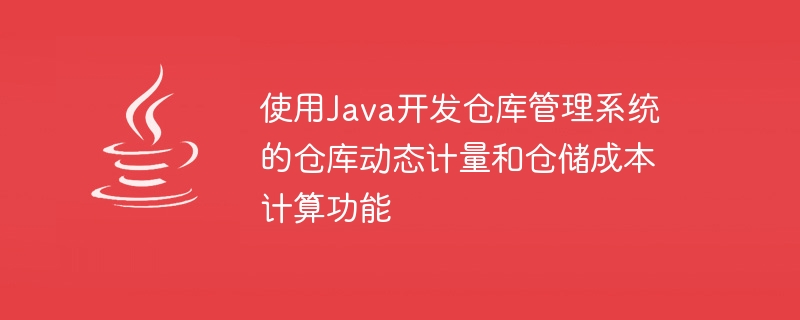

Using Java to develop warehouse dynamic measurement and warehousing cost calculation functions of the warehouse management system
Abstract: With the rapid development of e-commerce, the importance of warehouse management to enterprises increasingly prominent. This article will use Java to develop a warehouse management system, focusing on realizing the functions of warehouse dynamic measurement and warehousing cost calculation, and giving specific code examples.
In Java, you can implement the warehouse function in the warehouse management system by defining a class named "Warehouse". This class can contain a member variable named "items" for storing items in the warehouse. At the same time, by defining methods such as "addItem" and "removeItem", dynamic measurement and status updates of items in the warehouse can be achieved.
The following is a sample code:
public class Warehouse {
private Map<String, Integer> items;
public Warehouse() {
items = new HashMap<>();
}
public void addItem(String item, int quantity) {
if (items.containsKey(item)) {
items.put(item, items.get(item) + quantity);
} else {
items.put(item, quantity);
}
}
public void removeItem(String item, int quantity) {
if (items.containsKey(item)) {
int currentQuantity = items.get(item);
if (currentQuantity > quantity) {
items.put(item, currentQuantity - quantity);
} else {
items.remove(item);
}
}
}
public int getItemQuantity(String item) {
return items.getOrDefault(item, 0);
}
}In the above code, the "items" variable is a collection of key-value pairs, where the key is the name of the item and the value is the quantity of the item. Through the "addItem" method, you can add items with a specified name and quantity to the warehouse; through the "removeItem" method, you can remove items with a specified name and quantity from the warehouse; through the "getItemQuantity" method, you can query an item in the warehouse. quantity.
Through the above example code, the dynamic measurement function of warehouse items can be realized, and the quantity and status of various items in the warehouse can be grasped in real time.
In Java, the calculation of warehousing costs can be achieved by defining a class named "CostCalculator". This class can contain some member variables, such as warehouse rent, labor costs, etc., and define some methods to calculate the sum of these costs.
The following is a sample code:
public class CostCalculator {
private double rent; // 仓库租金
private double laborCost; // 人工费用
// ...
public CostCalculator(double rent, double laborCost) {
this.rent = rent;
this.laborCost = laborCost;
// ...
}
public double calculateTotalCost() {
double totalCost = rent + laborCost;
// 计算其他费用的总和
// ...
return totalCost;
}
}"rent" and "laborCost" in the above code represent warehouse rent and labor costs respectively. With the "calculateTotalCost" method, the sum of all relevant costs can be calculated.
Through the above example code, the calculation function of warehousing costs can be realized, helping enterprises to rationally arrange warehouse management and reduce warehousing costs.
In practical applications, the warehouse management system can be further improved and other functions can be added, such as inventory warnings, entry and exit records, etc., to meet the needs of enterprises for warehouse management.
The above is the detailed content of Using Java to develop the warehouse dynamic measurement and warehousing cost calculation functions of the warehouse management system. For more information, please follow other related articles on the PHP Chinese website!




